Laxmikanth Summary: Union & its Territory | Indian Polity for UPSC CSE PDF Download
| Table of contents |

|
| Part 1 of the Indian Constitution |

|
| Exchange of Territories with Bangladesh |

|
| Evolution of States and Union Territories in India |

|
| New States and Union Territories in India After 1956 |

|
Part 1 of the Indian Constitution
Part I of the Indian Constitution is titled The Union and its Territory.
- It includes articles from 1- 4.
- Part I is a compilation of laws pertaining to the constitution of India as a country and the union of states that it is made of.
- This part of the constitution contains the law in the establishment, renaming, merging, or altering of the borders of the states.
- Articles under Part I were invoked when West Bengalwas renamed and for the formation of relatively new states such as Jharkhand, Chhattisgarh, or Telangana.
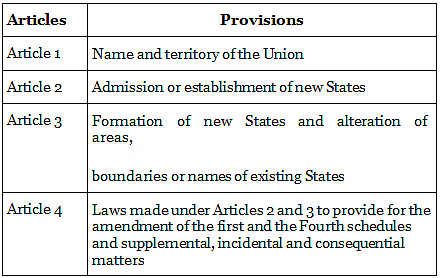
Articles 1 to 4 under Part-I of the Constitution deal with the Union and its territory.
Article 1
Article 1 deals with the Name and territory of the Union
- India, that is Bharat, shall be a Union of States.
- The States and the territories thereof shall be as specified in the First Schedule.
- The territory of India shall comprise - the territories of the States; the Union territories specified in the First Schedule; and Such other territories as may be acquired.
Article 2
Article 2 deals with admission or establishment of new States.
- Parliament may by law admit into the Union, or establish, new States on such terms and conditions as it thinks fit.
- Article 2 grants two powers to the Parliament:
- the power to admit into the Union of India new states
the power to establish new states.
Article 3
Formation Of New States And Alteration Of Areas, Boundaries Or names Of Existing State.
Parliament may by law:
- form a new State by separation of territory from any State or by uniting two or more States or parts of States or by uniting any territory to a part of any State;
- increase the area of any State
- diminish the area of any State
- alter the boundaries of any State
- alter the name of any State.
Article 3 notably relates to the formation of or changes in the existing states of the Union of India.
However, Article 3 lays down two conditions in this regard:
- One, a bill contemplating the above changes can be introduced in the Parliament only with the prior recommendation of the President; and
- Two, before recommending the bill, the President has to refer the same to the state legislature concerned for expressing its views within a specified period.
- The President (or Parliament) is not bound by the views of the state legislature and may either accept or reject them, even if the views are received in time.
- Further, it is not necessary to make a fresh reference to the state legislature every time an amendment to the bill is moved and accepted in Parliament.
- In the case of a union territory, no reference need be made to the concerned legislature to ascertain its views and the Parliament can itself take any action as it deems fit.
Article 4
Article 4: declares that laws made under Article 2 and 3 are not to be considered as amendments of the Constitution under Article 368
- Article 4 declares that laws made for admission or establishment of new states (under Article 2) and formation of new states and alteration of areas, boundaries, or names of existing states (under Articles 3) are not to be considered as amendments of the Constitution under Article 368.
This means that such laws can be passed by a simple majority and by the ordinary legislative process.
The Supreme Court held that the power of Parliament to diminish the area of a state (under Article 3).
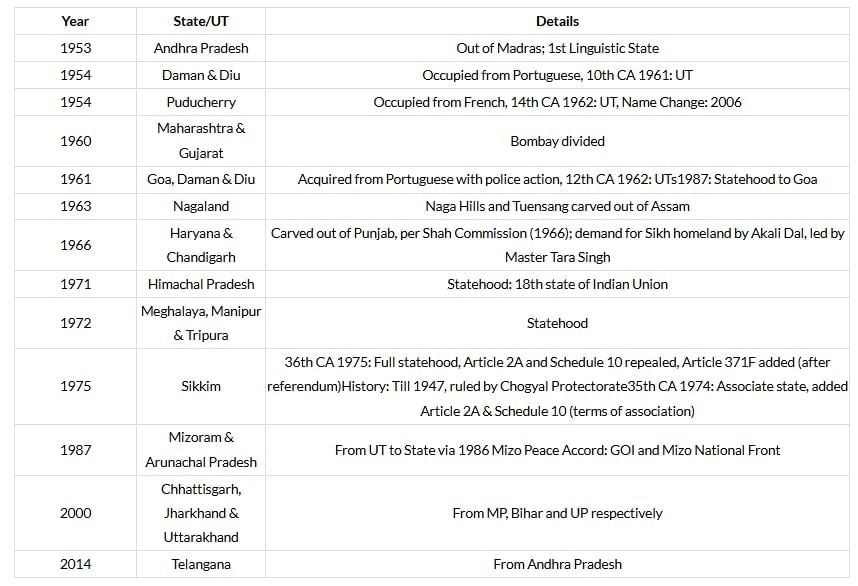 Formation of States and Union Territories
Formation of States and Union Territories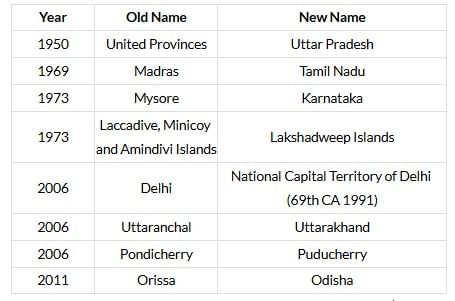 State/UT Name Changes
State/UT Name Changes
Exchange of Territories with Bangladesh
The 100th Constitutional Amendment Act of 2015 facilitated the exchange of territories between India and Bangladesh. This exchange involved the transfer of enclaves, adverse possessions, and the demarcation of border stretches.
Background
- India and Bangladesh share a common land boundary of about 4096.7 kilometers, established by the Radcliffe Award of 1947.
- Disputes arose regarding certain provisions of the Radcliffe Award, leading to attempts to resolve them through agreements like the Bhadra Award of 1950 and the Nehru-Noon Agreement of 1958.
- The Berubari Union division issue was contested in the Supreme Court, resulting in the passage of the Constitution (9th Amendment) Act in 1960.
- Due to ongoing legal battles and political changes, the 1960 Amendment was not implemented for territories in what is now Bangladesh.
- An Agreement signed on May 16, 1974, aimed to demarcate the land boundary between India and Bangladesh. However, this Agreement was not ratified as it involved the transfer of territory requiring a Constitutional Amendment.
- India transferred 111 enclaves to Bangladesh, while Bangladesh transferred 51 enclaves to India.
- The agreement also included the transfer of adverse possessions and the demarcation of a 6.1 km undemarcated border stretch.
- The 100th Constitutional Amendment Act modified the provisions related to the territories of four states (Assam, West Bengal, Meghalaya, and Tripura) in the First Schedule of the Constitution.
Land Boundary Agreement
- To resolve boundary issues, a Protocol was signed on September 6, 2011, addressing the demarcation of undemarcated boundaries, territories in adverse possession, and the exchange of enclaves.
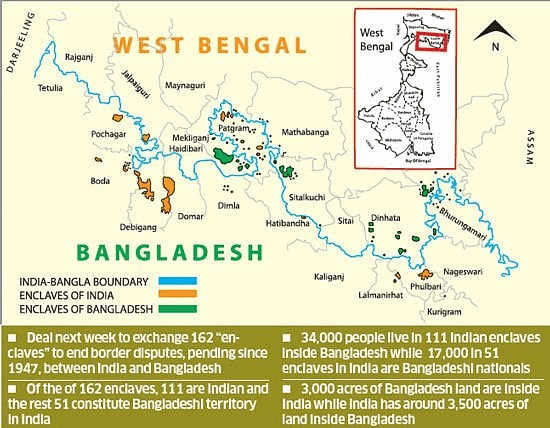
- The Protocol was developed with the involvement and agreement of the state governments of Assam, Meghalaya, Tripura, and West Bengal.
Evolution of States and Union Territories in India
At the time of India's independence, the country was made up of two main types of regions: British provinces (directly ruled by the British government) and princely states (ruled by native princes but under the overall authority of the British Crown). Let's simplify and elaborate on the evolution of states and union territories in India:
Integration of Princely States
- After independence in 1947, India was divided into two dominions: India and Pakistan.
- Princely states had the option to join either of these dominions or remain independent.
- Out of the 552 princely states in India, 549 chose to join India.
- The remaining 3 states—Hyderabad, Junagarh, and Kashmir initially refused to join India but were later integrated by different means.
- Hyderabad was integrated through police action, Junagarh through a referendum, and Kashmir through the Instrument of Accession.
- In 1950, the Indian Constitution classified states and territories into four categories: Part A, Part B, Part C states, and Part D territories, totaling 29 in number.
- Part A states included the former governor's provinces of British India, Part B states comprised princely states with legislatures, and Part C states were centrally administered regions that included chief commissioner's provinces and some princely states.
- There were 10 Part C states in total. The Andaman and Nicobar Islands were designated as the only Part D territory.
Dhar Commission and JVP Committee
- There has been a demand from different regions, particularly South India, for the reorganization of states on a linguistic basis.
- Accordingly, in June 1948, the Government of India appointed the Linguistic Provinces Commission under the chairmanship of S K Dhar to examine the feasibility of this.
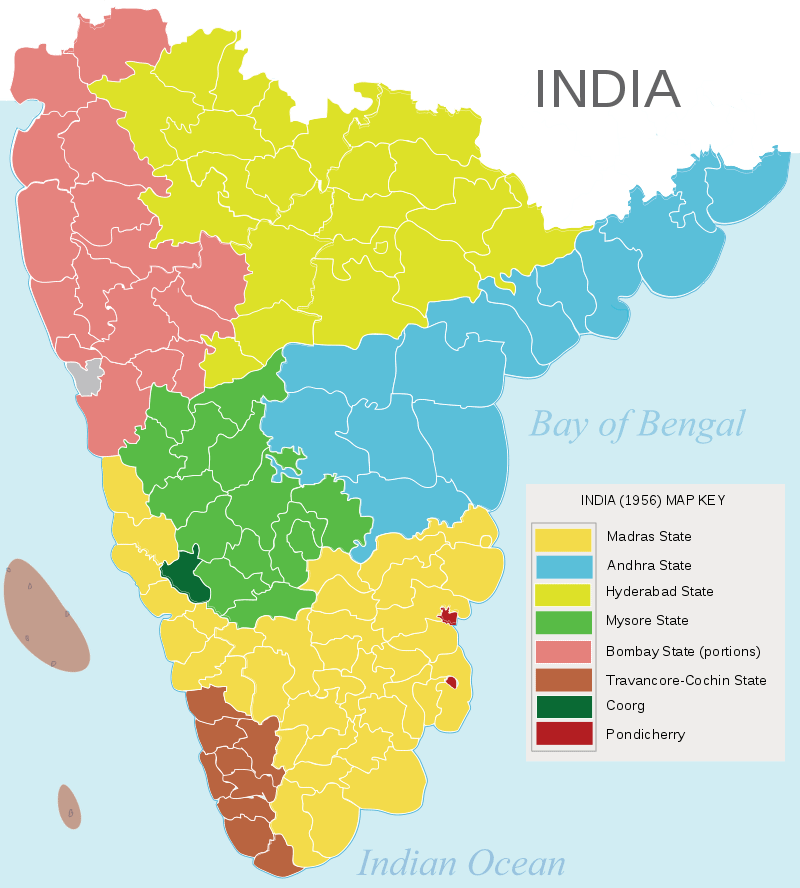 South Indian States prior to the States Reorganisation Act.
South Indian States prior to the States Reorganisation Act.
- The commission submitted its report in December 1948 and recommended the reorganization of states on the basis of administrative convenience rather than linguistic factors. This created much resentment and led to the appointment of another Linguistic Provinces Committee by the Congress in December 1948 itself to examine the whole question afresh. It consisted of Jawaharlal Nehru, Vallahbhai Patel, and Pattabhi Sitaramayya and hence was popularly known as JVP Committee.
- It submitted its report in April 1949 and formally rejected language as the basis for the reorganization of states. However, in October 1953, the Government of India was forced to create the first linguistic state, known as Andhra state.
Fazl Ali Commission
The Fazl Ali Commission was established in response to the growing demand for states based on language following the creation of the Andhra State. Appointed in December 1953, the commission, chaired by Fazl Ali, aimed to reassess the entire matter of state reorganisation. Let's delve into the key points and outcomes of the commission's report.The commission, led by Fazl Ali and comprising K.M. Panikkar and H.N. Kunzru, submitted its report in September 1955.
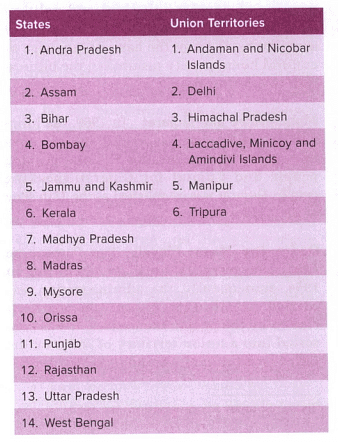 Territory of India in 1956
Territory of India in 1956
Key Recommendations of the Commission
The commission accepted language as a basis for reorganising states but rejected the concept of 'one language—one state.' It emphasized the unity of India as a primary consideration in state reorganisation.
The commission identified four major factors for state reorganisation:
- Preservation and strengthening of the country's unity and security.
- Linguistic and cultural homogeneity.
- Financial, economic, and administrative considerations.
- Planning and promotion of welfare at both state and national levels.
Proposed Changes by the Commission
The commission recommended the abolition of the original four-fold classification of states and territories, proposing the creation of 16 states and 3 centrally administered territories.
Following the commission's suggestions, the Government of India enacted the States Reorganisation Act (1956) and the 7th Constitutional Amendment Act (1956), which led to the creation of 14 states and 6 union territories on November 1, 1956.
The distinction between Part A and Part B states was eliminated, and Part C states were done away with. Some were merged with neighboring states while others were designated as union territories.
New States and Union Territories in India After 1956
Following the major reorganization of states in 1956, India's political map continued to evolve due to public demands and political circumstances. Several new states and union territories were created to address linguistic or cultural similarities, leading to the division of existing regions.
Maharashtra and Gujarat
- Maharashtra and Gujarat emerged as separate states from the bilingual state of Bombay in 1960. Maharashtra was formed for Marathi-speaking people, while Gujarat was established for Gujarati-speaking individuals.
- Gujarat became the 15th state of the Indian Union.
Dadra and Nagar Haveli
- Previously under Portuguese rule until liberation in 1954, Dadra and Nagar Haveli became a union territory of India in 1961 through the 10th Constitutional Amendment Act.
- In 2020, this territory merged with Daman and Diu to form the new union territory of Dadra and Nagar Haveli and Daman and Diu via the Dadra and Nagar Haveli and Daman and Diu (Merger of Union Territories) Act, 2019.
Goa, Daman, and Diu
- India acquired Goa, Daman, and Diu from Portugal in 1961, constituting them as a union territory through the 12th Constitutional Amendment Act in 1962.
- In 1987, Goa was granted statehood, leading to Daman and Diu becoming a separate union territory.
- Later in 2020, Daman and Diu merged with Dadra and Nagar Haveli to form the new union territory of Dadra and Nagar Haveli and Daman and Diu, facilitated by the Dadra and Nagar Haveli and Daman and Diu (Merger of Union Territories) Act, 2019.
Puducherry
- The area of Puducherry includes territories formerly held by the French in India, comprising Puducherry, Karaikal, Mahe, and Yanam.
- France transferred control of this region to India in 1954, initially managing it as an 'acquired territory' until it became a union territory in 1962 through the 14th Constitutional Amendment Act.
Nagaland
- In 1963, Nagaland was created by separating the Naga Hills and Tuensang area from Assam to address the demands of the Naga people.
- Prior to gaining statehood as the 16th state of India, Nagaland was under the governance of the Assam governor in 1961.
Haryana, Chandigarh, and Himachal Pradesh
- In 1966, Punjab was divided to form Haryana as the 17th state and Chandigarh as a union territory.
- The Shah Commission's recommendation led to the linguistic division, creating Punjabi-speaking Punjab, Hindi-speaking Haryana, and merging the hilly areas with Himachal Pradesh. Himachal Pradesh later became a state in 1971.
Manipur, Tripura, and Meghalaya
- In 1972, Manipur and Tripura transitioned from union territories to states, while Meghalaya was also granted statehood.
- Mizoram and Arunachal Pradesh were carved out of Assam's territories during this reorganization.
Sikkim
- Till 1947, Sikkim was a princely state in India ruled by a leader called Chogyal.
- In 1947, after British control ended, Sikkim became a 'protectorate' of India. This meant that India took responsibility for Sikkim's defense, foreign affairs, and communications.
- By 1974, Sikkim wanted closer ties with India. The 35th Constitutional Amendment Act of 1974 made Sikkim an 'state' of India, creating a new type of statehood with specific terms and conditions.
- However, this arrangement didn't last long because it didn't fully meet the wishes of the people in Sikkim. In a vote in 1975, they chose to do away with the Chogyal institution and integrate Sikkim fully into India.
- Following this decision, the 36th Constitutional Amendment Act of 1975 was passed, making Sikkim the 22nd state of India. This amendment included special provisions for Sikkim's administration and removed the changes made by the 35th Amendment Act.
Mizoram, Arunachal Pradesh, and Goa
- In 1987, three new states were added to the Indian Union - Mizoram, Arunachal Pradesh, and Goa.
- This happened after a peace agreement was signed between the Central government and the Mizo National Front, ending a long-standing insurgency.
Chhattisgarh, Uttarakhand, and Jharkhand
In the year 2000, three more states were carved out of existing territories - Chhattisgarh, Uttarakhand, and Jharkhand. These states were formed from parts of Madhya Pradesh, Uttar Pradesh, and Bihar, respectively.
Telangana
- In 2014, Telangana became the 29th state of the Indian Union. It was separated from Andhra Pradesh to become an independent state.
- The Andhra State Act of 1953 marked the creation of the first linguistic state in India, Andhra Pradesh. This state was formed by separating Telugu-speaking areas from Madras state and had Kurnool as its capital.
- States Reorganisation Act (1956): This act merged Telugu-speaking areas of Hyderabad state with Andhra state, forming an enlarged Andhra Pradesh with Hyderabad as its capital.
- Andhra Pradesh Reorganisation Act (2014): In 2014, Andhra Pradesh was divided into two separate states - Andhra Pradesh (residuary) and Telangana, leading to the creation of Telangana as a distinct state.
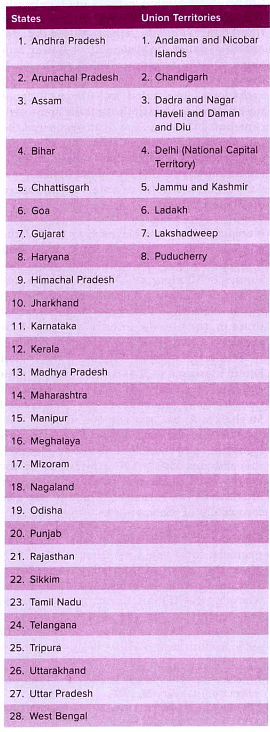 Territory of India
Territory of India
Jammu & Kashmir and Ladakh
- The State of Jammu and Kashmir had special privileges under Article 370 of the Indian Constitution until 2019.
- In 2019, Article 370 was revoked through "The Constitution (Application to Jammu and Kashmir) Order, 2019," which brought the region under the complete purview of the Indian Constitution.
- The Jammu and Kashmir Reorganisation Act, 2019, divided the former state into two union territories: Jammu and Kashmir, and Ladakh.
- Jammu and Kashmir now function as a union territory, consisting of all districts except Kargil and Leh, which are part of the union territory of Ladakh.
Expansion of States and Union Territories
- The number of states in India increased from 14 in 1956 to 28 at present.
- Similarly, the count of union territories rose from 6 in 1956 to 8 currently.
Rename of States and Union Territories
- The renaming of states and union territories has also been a part of these changes over the years.
- Examples include the renaming of the United Provinces to 'Uttar Pradesh', Madras to 'Tamil Nadu', Mysore to 'Karnataka', and so on.
- Delhi was redesignated as the National Capital Territory of Delhi without being granted full statehood.
- Other renamings include Uttaranchal to 'Uttarakhand', Pondicherry to 'Puducherry', and Orissa to 'Odisha'.
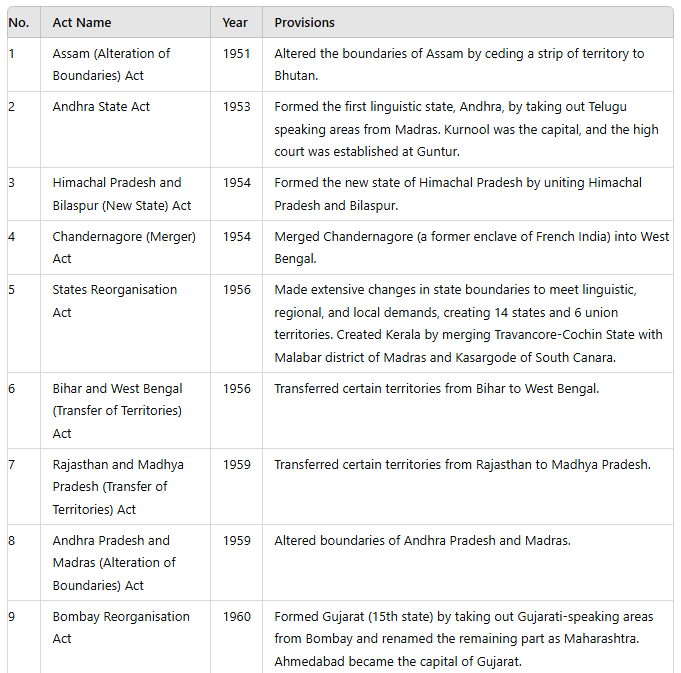
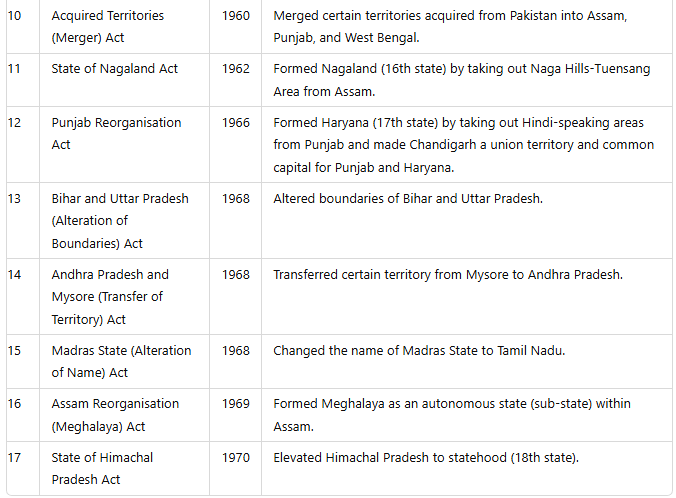
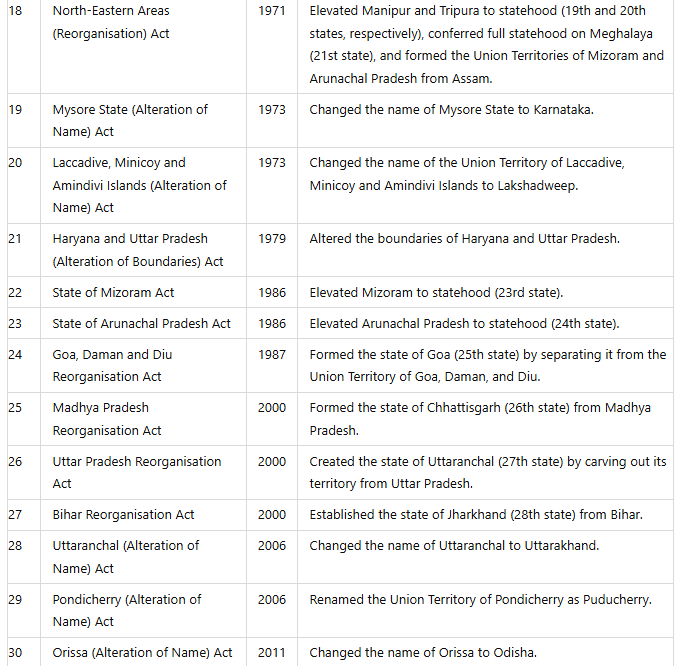

|
142 videos|779 docs|202 tests
|
FAQs on Laxmikanth Summary: Union & its Territory - Indian Polity for UPSC CSE
| 1. What is the significance of the Union of States in India? |  |
| 2. How does Parliament exercise its power to reorganize states in India? |  |
| 3. What was the impact of the exchange of territories with Bangladesh on India's territorial integrity? |  |
| 4. How did the integration of princely states contribute to the formation of modern India? |  |
| 5. What are some examples of new states and union territories created in India after 1956? |  |
















